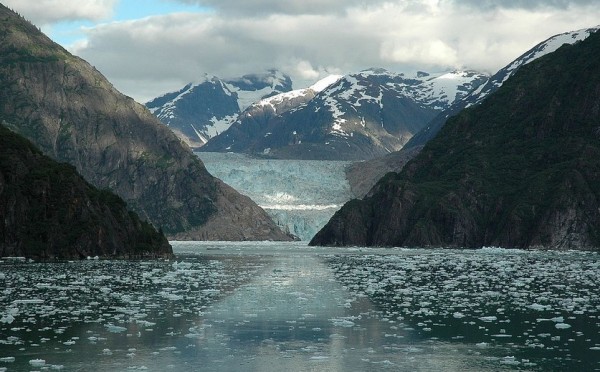How Fjords Can Soak Up Carbon and Fight Climate Change
| Ana Verayo | | May 05, 2015 06:24 AM EDT |
(Photo : Wikipedia) Tracy Arm Fjord in Alaska
A new study revealed that fjords of Alaska and Norway can suck in potentially damaging carbon from the Earth's atmosphere that make these steep inlets between mountain ranges an effective natural ally for combating the effects of climate change.
Fjords apparently cover only 0.1 percent of the planet's oceans however, they also account for 11 percent of organic carbon from plants, soil and rock that are embedded with marine sediments each year when they are carried off from the land via rivers.
Like Us on Facebook
Scientists believe that these cliff sided inlets that are carved from glaciers during numerous ice ages are also the ocean's major hotspots for organic carbon burial which is based on carbon found per unit area.
These new findings also contribute to a clearer understanding of how carbon which is also a building block for life on Earth, can go through natural cycles and eventually beat man made climate change from greenhouse gases.
Carbon dioxide is the main proponent of these greenhouse gases that can increase global warming. Fjords are truly effective in carbon storage since they originate from deep, heavy flowing, carbon rich waters from rivers that often possess calm and often oxygen depleted water where carbon rapidly and naturally sinks without the interference of bacteria.
All over the world, these fjords are estimated to absorb and capture 18 million tons of carbon every year according to this new study especially fjords that are located in Nordic countries such as Greenland, Canada and Alaska including Chile, New Zealand and Antarctica.
According to Richard Smith from the Global Aquatic Research in New York, fjords are mostly ignored as places that can have the largest potential to store massive amounts of carbon.
When plants die, carbon will then get buried underneath soil and then washes off into the river or released back into the atmosphere thru gases from vegetation rot. However man made greenhous gases are released from fossil fuels, power plants, automobiles and homes which makes studying the role of carbon important and how natural carbon burial from fjords can help fight climate change.
This study is published in the journal Nature Geoscience.
Tagsfjords, fjords alaska greenland canada, fjords climate change soak carbon, global warming, fjords soak up carbon, Greenhouse gases, organic carbon burial
©2015 Chinatopix All rights reserved. Do not reproduce without permission
EDITOR'S PICKS
-

Did the Trump administration just announce plans for a trade war with ‘hostile’ China and Russia?
-

US Senate passes Taiwan travel bill slammed by China
-

As Yan Sihong’s family grieves, here are other Chinese students who went missing abroad. Some have never been found
-

Beijing blasts Western critics who ‘smear China’ with the term sharp power
-

China Envoy Seeks to Defuse Tensions With U.S. as a Trade War Brews
-

Singapore's Deputy PM Provides Bitcoin Vote of Confidence Amid China's Blanket Bans
-

China warns investors over risks in overseas virtual currency trading
-

Chinese government most trustworthy: survey
-

Kashima Antlers On Course For Back-To-Back Titles
MOST POPULAR
LATEST NEWS
Zhou Yongkang: China's Former Security Chief Sentenced to Life in Prison

China's former Chief of the Ministry of Public Security, Zhou Yongkang, has been given a life sentence after he was found guilty of abusing his office, bribery and deliberately ... Full Article
TRENDING STORY

China Pork Prices Expected to Stabilize As The Supplies Recover

Elephone P9000 Smartphone is now on Sale on Amazon India

There's a Big Chance Cliffhangers Won't Still Be Resolved When Grey's Anatomy Season 13 Returns

Supreme Court Ruled on Samsung vs Apple Dispute for Patent Infringement

Microsoft Surface Pro 5 Rumors and Release Date: What is the Latest?










